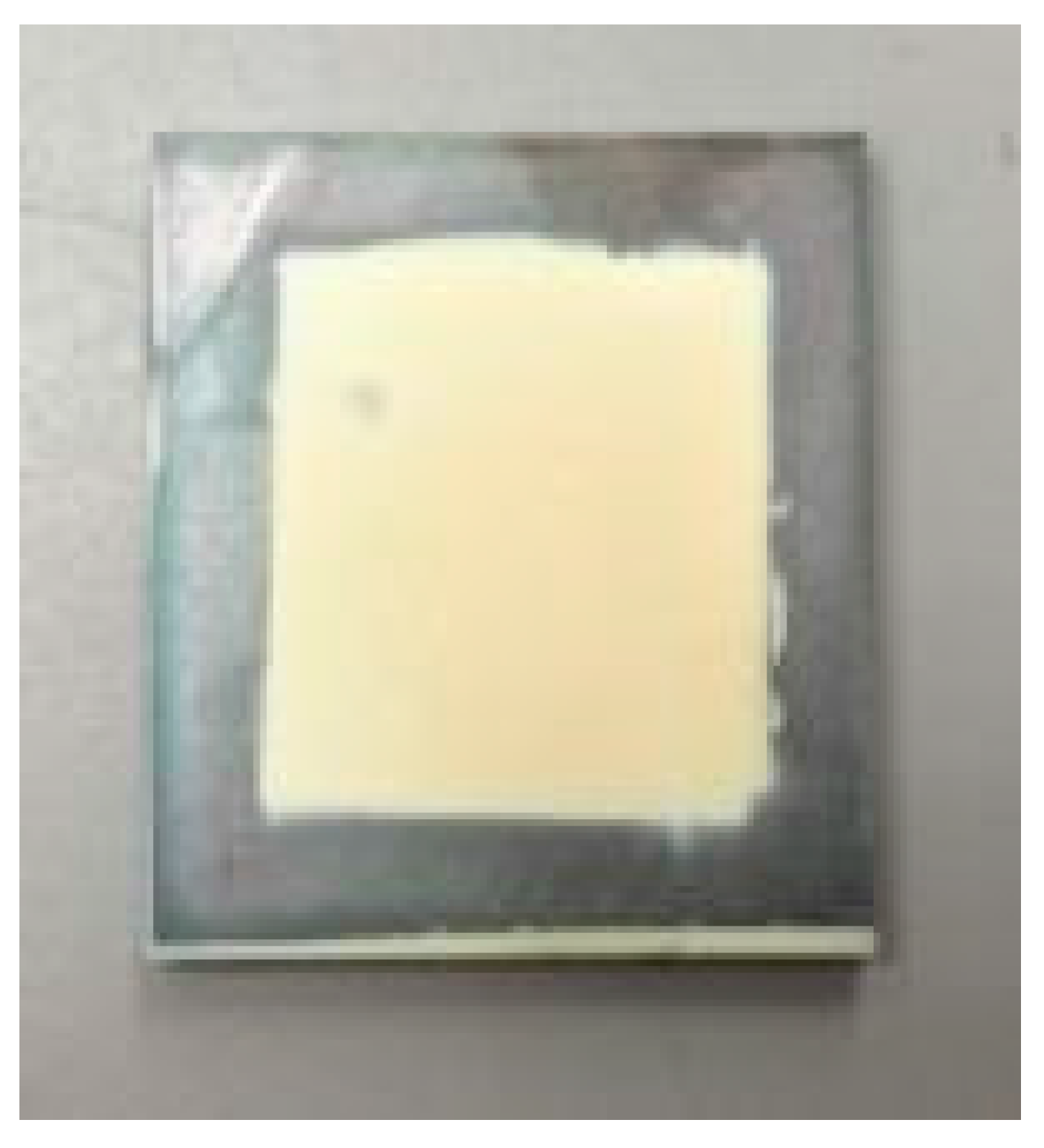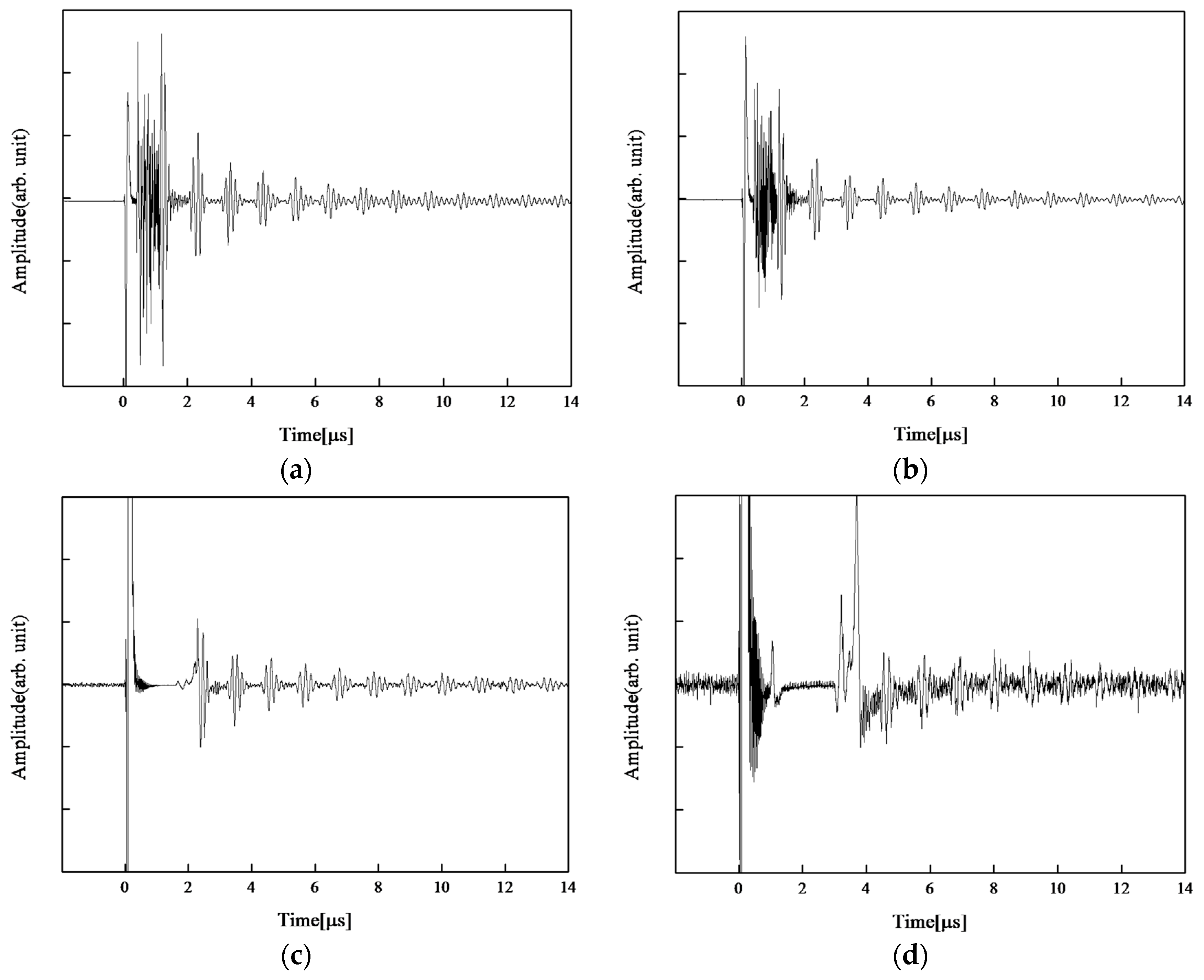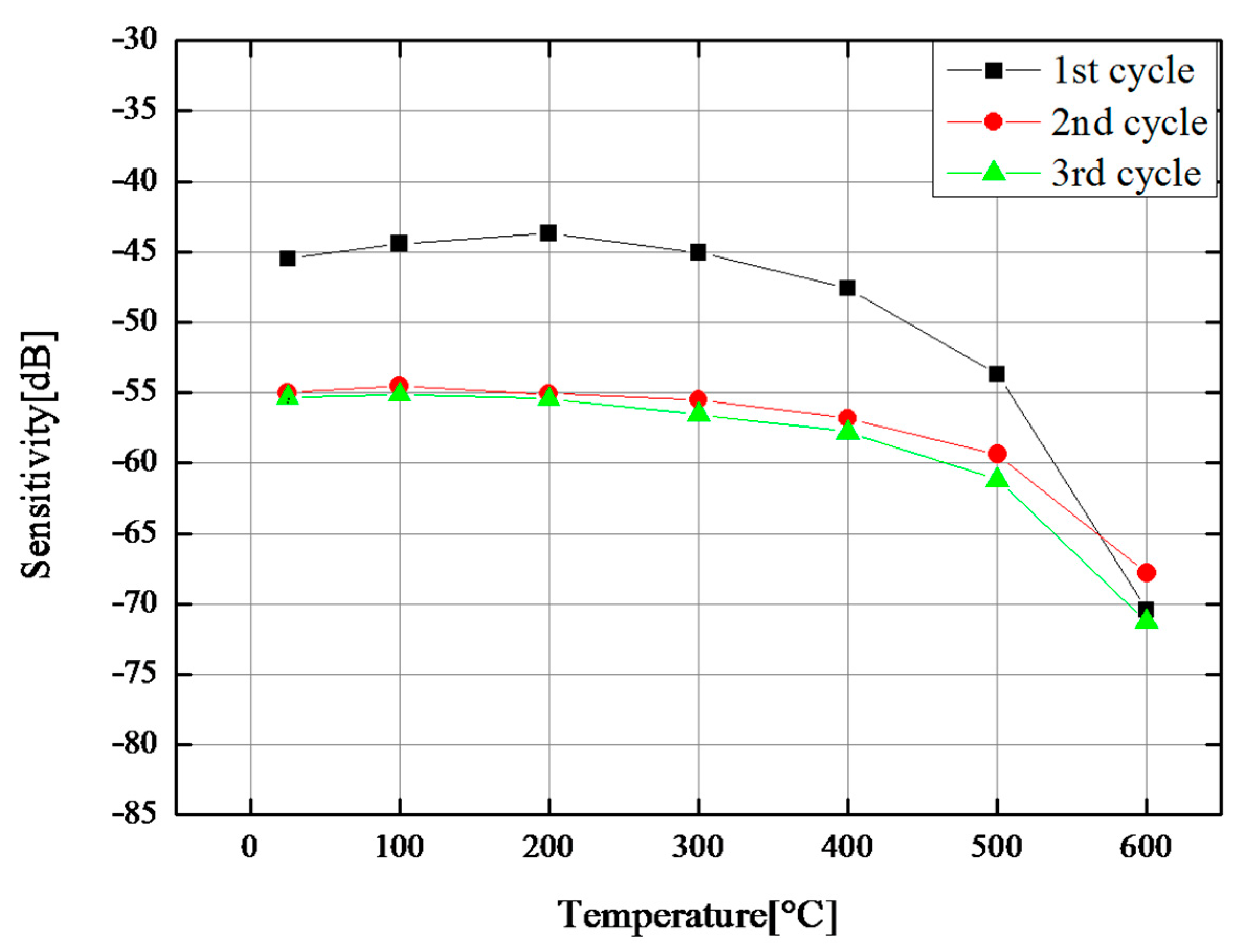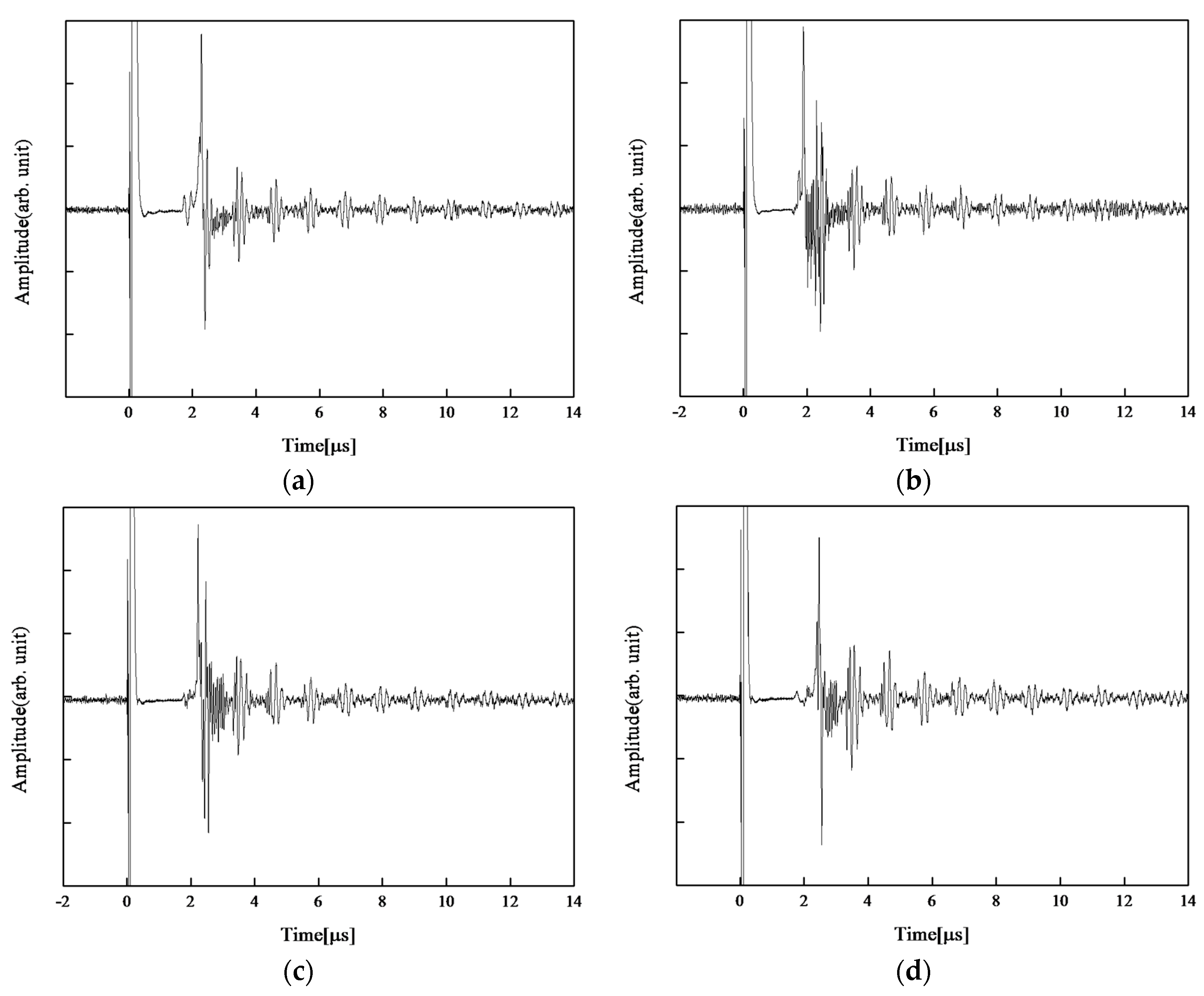Mn-Doped CaBi4Ti4O15/Pb(Zr,Ti)O3 Ultrasonic Transducers for Continuous Monitoring at Elevated Temperatures
Abstract
:1. Introduction
2. Materials and Methods
3. Results and Discussions
3.1. Maximum Operating Temperature Test
3.2. Thermal Cycle Test
3.3. Long-Term Ultrasonic Monitoring at 600 °C
4. Conclusions
Acknowledgments
Author Contributions
Conflicts of Interest
References
- Raj, B.B.; Chellapandi, P.; Jayakumar, T.; Rao, B.P.C.; Rao, K.B.S. Plant life management (PLiM) practices for sodium cooled fast neutron spectrum nuclear reactors (SFRs). In Understanding and Mitigating Ageing in Nuclear Power Plants; Tipping, P.G., Ed.; Woodhead Publishing: Cambridge, UK, 2010; pp. 795–837. [Google Scholar]
- Jen, C.K.; Sun, A.; Tatibouët, J.; Ono, Y. Real-time and in-line ultrasonic diagnostics of polymer processes. In Ultrasonic and Advanced Methods for Nondestructive Testing and Material Characterization; Chen, C.H., Ed.; World Scientific Publishing: Singapore, 2007; pp. 57–77. [Google Scholar]
- Monchalin, J.P. Laser-ultrasonics: Principles and industrial applications. In Ultrasonic and Advanced Methods for Nondestructive Testing and Material Characterization; Chen, C.H., Ed.; World Scientific Publishing: Singapore, 2007; pp. 79–115. [Google Scholar]
- Krautkrämer, J.; Krautkrämer, H. Pulse-echo method. In Ultrasonic Testing of Materials, 3rd ed.; Springer: Berlin, Germany, 1983; pp. 193–264. [Google Scholar]
- Uchino, K. Ferroelectric devices. In Materials Engineering; Marcel Dekker: New York, NY, USA, 2000; Volume 16, pp. 145–220. [Google Scholar]
- Bhardwaj, M.C. Non-destructive evaluation: introduction of non-contact ultrasound. In Encyclopedia of Smart Materials; Schwartz, M., Ed.; John Wiley & Sons: New York, NY, USA, 2002; pp. 690–714. [Google Scholar]
- Burrows, S.E.; Fan, Y.; Dixon, S. High temperature thickness measurements of stainless steel and low carbon steel using electromagnetic acoustic transducers. NDT E Int. 2014, 68, 73–77. [Google Scholar] [CrossRef]
- Cegla, F.B.; Cawley, P.; Allin, J.; Davies, J. High-temperature (>500 °C) wall thickness monitoring using dry-coupled ultrasonic waveguide transducers. IEEE Trans. Ultrason. Ferroelect. Freq. Control 2011, 58, 156–167. [Google Scholar] [CrossRef] [PubMed]
- Barrow, D.A.; Petroff, T.E.; Tandon, R.P.; Sayer, M. Characterization of thick lead zirconate titanate films fabricated using a new sol-gel based process. J. Appl. Phys. 1997, 81, 876–881. [Google Scholar] [CrossRef]
- Kobayashi, M.; Jen, C.K.; Ono, Y.; Moison, J.P. Integratable high temperature ultrasonic transducers for NDT of metals and industrial process monitoring. CINDE J. 2005, 26, 5–10. [Google Scholar]
- Kobayashi, M.; Ono, Y.; Jen, C.K.; Cheng, C.C. High-temperature piezoelectric film ultrasonic transducers by a sol-gel spray technique and their application to process monitoring of polymer injection molding. IEEE Sens. J. 2006, 6, 55–62. [Google Scholar] [CrossRef]
- Kobayashi, M.; Jen, C.K.; Bussiere, J.; Wu, K.T. High-temperature integrated and flexible ultrasonic transducers for nondestructive testing. NDT E Int. J. 2009, 42, 157–161. [Google Scholar] [CrossRef] [Green Version]
- Kimoto, K.; Matsumoto, M.; Kaneko, T.; Kobayashi, M. Sol-gel composite material characteristics caused by different dielectric constant sol-gel phase. Jpn. J. Appl. Phys. 2016, 55, 07KB04. [Google Scholar] [CrossRef]
- Inada, Y.; Inoue, T.; Kobayashi, M.; Nagata, H.; Takenaka, T. High-temperature performance of Mn-doped CaBi4Ti4O15/Pb(Zr,Ti)O3 ultrasonic transducers. Jpn. J. Appl. Phys. 2014, 53, 07KB10. [Google Scholar] [CrossRef]
- Kibe, T.; Kimoto, K.; Kobayashi, M.; Nagata, H.; Takenaka, T. Continuous monitoring at 600 °C by CaBi4Ti4O15/Pb(Zr,Ti)O3 sol-gel composite ultrasonic transducer. In Proceedings of the 2016 IEEE International Ultrasonics Symposium, Tours, France, 18–21 September 2016. [Google Scholar]
- Inada, Y.; Kobayashi, M.; Nagata, H.; Takenaka, T. Sol-gel composite materials for continuous monitoring at 600 °C. In Proceedings of the 2015 IEEE International Ultrasonics Symposium, Taipei, Taiwan, 21–24 October 2015. [Google Scholar]
- Ogawa, H.; Kawada, S.; Kimura, M.; Shiratsuyu, K.; Sakabe, Y. High-power piezoelectric characteristics of textured bismuth layer structured ferroelectric ceramics. IEEE Trans. Ultrason. Ferroelect. Freq. Control 2007, 54, 2500–2504. [Google Scholar] [CrossRef] [PubMed]







© 2017 by the authors. Licensee MDPI, Basel, Switzerland. This article is an open access article distributed under the terms and conditions of the Creative Commons Attribution (CC BY) license (http://creativecommons.org/licenses/by/4.0/).
Share and Cite
Kobayashi, M.; Kibe, T.; Nagata, H. Mn-Doped CaBi4Ti4O15/Pb(Zr,Ti)O3 Ultrasonic Transducers for Continuous Monitoring at Elevated Temperatures. Sensors 2017, 17, 2740. https://doi.org/10.3390/s17122740
Kobayashi M, Kibe T, Nagata H. Mn-Doped CaBi4Ti4O15/Pb(Zr,Ti)O3 Ultrasonic Transducers for Continuous Monitoring at Elevated Temperatures. Sensors. 2017; 17(12):2740. https://doi.org/10.3390/s17122740
Chicago/Turabian StyleKobayashi, Makiko, Taiga Kibe, and Hajime Nagata. 2017. "Mn-Doped CaBi4Ti4O15/Pb(Zr,Ti)O3 Ultrasonic Transducers for Continuous Monitoring at Elevated Temperatures" Sensors 17, no. 12: 2740. https://doi.org/10.3390/s17122740




